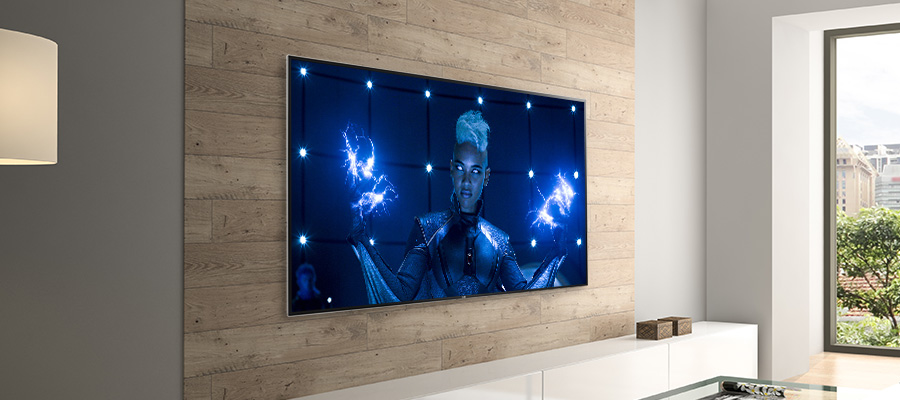4K Ultra HD Technology - Definition And Use Case
4K Ultra HD technology is everywhere now. Lots of new movies, shows, and video games are made especially for 4K screens. Even if you don't watch 4K stuff yet, most 4K TVs can make lower-quality stuff look better.
Author:Elisa MuellerReviewer:James PierceFeb 12, 20243K Shares44.6K Views

4K Ultra HD technologyis everywhere now. Lots of new movies, shows, and video games are made especially for 4K screens. Even if you don't watch 4K stuff yet, most 4K TVs can make lower-quality stuff look better. So, is it a good idea to switch from your old HD TV to a new 4K one? Let's learn more about 4K Ultra HD Technology to decide.
What Is 4K Ultra HD Technology?
4K Ultra HD (Ultra High Definition) technology refers to a display resolution that offers significantly higher pixel density compared to standard high definition (HD) resolutions. Specifically, 4K resolution measures approximately 3840 pixels wide by 2160 pixels tall, resulting in four times the resolution of 1080p HD.
The term "4K" comes from the horizontal resolution, which is roughly 4000 pixels. This increased resolution delivers sharper, more detailed images with enhanced clarity and depth. It's particularly noticeable on larger screens or when viewed up close, providing a more immersive viewing experience for content like movies, TV shows, and video games.
4K Ultra HD technology is becoming increasingly popular in televisions, computer monitors, cameras, and other display devices, offering users the ability to enjoy content in stunning detail and clarity. Additionally, advancements like HDR (High Dynamic Range) further enhance the visual experience by improving contrast, color accuracy, and overall picture quality.
History Of 4K Ultra HD Technology
The history of 4K Ultra HD technology traces back to the early 2000s when discussions began about the need for higher resolution displays to meet the evolving demands of consumers for sharper and more immersive viewing experiences. Here's a brief overview of key milestones in the development of 4K Ultra HD technology:
- Emergence of high definition (HD) -The transition from standard definition to high definition (HD) resolution in the late 1990s and early 2000s laid the groundwork for advancements in display technology. HD offered significantly improved image quality compared to standard definition, but the quest for even higher resolutions persisted.
- Digital cinema initiatives (DCI) standardization -The Digital Cinema Initiatives (DCI) released a specification in 2005 outlining the requirements for digital cinema projection, which included a resolution of 4096 × 2160 pixels. This resolution became known as DCI 4K and was adopted for professional digital cinema projectors.
- Consumer electronics adoption -In the consumer electronics market, the term "4K" initially referred to a resolution of 3840 × 2160 pixels, which is slightly lower than the DCI standard but still four times the resolution of 1080p HD. Consumer electronics manufacturers began introducing 4K Ultra HD televisions and displays to the market around 2012.
- Content production and distribution -As 4K Ultra HD displays became more widespread, content creators started producing movies, TV shows, and streaming content in 4K resolution to cater to the growing demand. Streaming services like Netflix and Amazon Prime began offering 4K content, and Blu-ray discs with 4K resolution (Ultra HD Blu-ray) were introduced.
- Advancements in display technology -Alongside the increase in resolution, advancements in display technology, such as HDR (High Dynamic Range), wider color gamuts, and higher refresh rates, further improved the visual quality of 4K Ultra HD content. These enhancements contributed to an even more immersive viewing experience.
- Expansion into other devices -In addition to televisions, 4K Ultra HD technology expanded to other devices, including computer monitors, projectors, cameras, and smartphones. This proliferation of 4K-capable devices allowed users to capture, view, and share high-resolution content across various platforms.
- Future developments -Looking ahead, the development of higher resolutions, such as 8K (7680 × 4320 pixels), continues to push the boundaries of display technology. However, 4K Ultra HD remains a prevalent and widely adopted standard for high-quality viewing experiences across various entertainment mediums.
Benefits Of 4K Ultra HD Technology
4K Ultra HD technology offers several benefits that enhance the viewing experience compared to lower-resolution displays. Here are some of the key advantages:
- Higher resolution -The most obvious benefit of 4K Ultra HD technology is its higher resolution. With four times the number of pixels as 1080p HD displays, 4K resolution delivers sharper, more detailed images. This increased pixel density is especially noticeable on larger screens or when viewed up close, providing a more immersive visual experience.
- Enhanced clarity -The higher resolution of 4K Ultra HD displays results in greater clarity and finer detail in images and videos. This means that textures, patterns, and small elements within the picture are more distinct and lifelike, allowing viewers to see more nuance and depth in the content they're watching.
- Improved color accuracy -Many 4K Ultra HD displays are equipped with technologies like HDR (High Dynamic Range), which expands the range of colors and contrast for more vibrant and realistic imagery. HDR enhances color accuracy by reproducing a wider spectrum of colors and finer gradients between shades, resulting in more lifelike and dynamic visuals.
- Better immersion - The combination of higher resolution, enhanced clarity, and improved color accuracy creates a more immersive viewing experience. Whether watching movies, playing video games, or viewing photos, 4K Ultra HD technology draws viewers into the content with its lifelike detail and realism, making them feel more connected to what they're watching.
- Future-proofing -As content production continues to evolve, more movies, TV shows, and streaming services are offering 4K content. Investing in a 4K Ultra HD display ensures compatibility with current and future content offerings, future-proofing your entertainment setup for years to come.
- Upscaling capability -Even when viewing non-4K content, many 4K Ultra HD displays incorporate upscaling technology to enhance lower-resolution content to near-4K quality. This means that even DVDs, Blu-rays, and streaming content in lower resolutions can look better when displayed on a 4K screen, thanks to sophisticated upscaling algorithms.
- Versatility -4K Ultra HD technology isn't limited to televisions. It's also used in computer monitors, projectors, cameras, and smartphones, offering users the ability to enjoy high-resolution content across a variety of devices and applications.
Pitfalls Of 4K Ultra HD Technology
While 4K Ultra HD technology offers numerous benefits, there are also some potential pitfalls to consider:
- Cost -4K Ultra HD displays, especially high-end models with advanced features like HDR, can be more expensive than lower-resolution alternatives. Additionally, upgrading to 4K may require investing in compatible devices such as media players or gaming consoles, adding to the overall cost.
- Content availability -While the availability of 4K content has increased in recent years, it may still be limited compared to content in lower resolutions. Not all movies, TV shows, or streaming services offer 4K options, so users may not always be able to take full advantage of their 4K displays.
- Bandwidth and storage requirements -Streaming or downloading 4K content requires significantly more bandwidth and storage space compared to lower-resolution content. This can be a concern for users with limited internet bandwidth or storage capacity, as 4K files are larger and require more resources to handle.
- Performance demands -Playing 4K content, especially high-bitrate HDR content, can be demanding on hardware components like processors, graphics cards, and internet connections. Older or less powerful devices may struggle to handle 4K content smoothly, resulting in buffering, stuttering, or reduced image quality.
- Viewing distance -While 4K resolution offers increased detail and clarity, the benefits may not be as noticeable when viewing content from a distance, particularly on smaller screens. In some cases, users may need to sit closer to the screen than they're accustomed to to fully appreciate the higher resolution.
- Source quality -The visual quality of 4K content can vary depending on factors like the source material, production techniques, and encoding methods. Some 4K content may be upscaled from lower resolutions or exhibit compression artifacts, reducing the overall perceived quality.
- Compatibility -Not all devices or software applications may be fully compatible with 4K content. Older devices, software, or cables may not support 4K resolution or HDR, limiting the ability to enjoy the full benefits of 4K Ultra HD technology.
Use Case Of 4K Ultra HD Technology
With its unprecedented capabilities for shooting, editing, and transmitting high-quality footage, 4K Ultra HD technology is a vital instrument in the domain of professional video production and filmmaking. The capacity to record footage with astonishing clarity and detail is fundamental to this technology.
Filmmakers may now capture incredibly fine details with pinpoint accuracy using 4K cameras, which offer four times the resolution of normal high definition. This higher resolution enhances both the visual quality and the versatility of the finished product during post-production.
4K Ultra HD technology's interoperability with modern visual effects and CGI integration is one of the main advantages it offers in film production. Cinematic experiences are more vivid and immersive thanks to the higher resolution, which allows for the seamless integration of live-action and CGI footage.
Furthermore, by shooting in 4K, filmmakers can ensure that their content will be compatible with future display technology by delivering it at the greatest possible resolution. Creators can satisfy the growing need for high-quality viewing experiences with carefully designed images, thanks to the proliferation of 4K TVs and streaming services.
Moreover, 4K resolution allows for better color correction and grading, giving directors more leeway in how their films seem. Richer, more complex pictures are the consequence of higher pixel density, which enables more exact modifications to color, contrast, and overall image quality.
Before being released to theaters, streaming services, or physical media, many films undergo 4K mastering. The mastering process is crucial in preserving the film's quality and ensuring that it remains faithful throughout all distribution channels.
4K Ultra HD Technology - FAQ
Is 4K UHD Good Quality?
Truth be known, buying a 4K TV versus a UHD TV will not make much of a difference to the average viewer, with both offering excellent resolution. However, if having the highest possible picture clarity is essential to you, you'll want to look for a 4K unit that displays at 4,096 x 2,160.
Which Is Better OLED Or UHD?
UHD simply refers to a resolution of 4K or higher that can be achieved by most LG TVs. OLED, instead, refers to a type of display that makes use of self-lighting pixels to create the image on screen. In most ways, OLED TVs offer much greater image clarity and contrast, when compared to other UHD screens.
How Do I Know If My TV Is 4K?
Go to the TV settings and look for the display or picture options. The settings should display the TV's resolution, and if it's 4K, it should show a resolution of 3840 x 2160. Check the model number. You can check the model number of your TV and look it up online to confirm whether it is a 4K TV.
Finally
So, that's what 4K Ultra HD Technology is all about and how people use it. It's super clear and detailed pictures and videos on fancy screens. Whether it's making movies, playing games, or just watching shows, 4K Ultra HD Technology makes everything look awesome!

Elisa Mueller
Author

James Pierce
Reviewer
Latest Articles
Popular Articles

